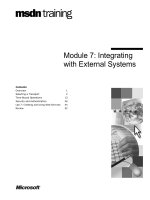Tài liệu High Availability Networking with NetWare 6: NSS 3.0 and Cluster doc
Bạn đang xem bản rút gọn của tài liệu. Xem và tải ngay bản đầy đủ của tài liệu tại đây (249.87 KB, 12 trang )
Feature Article
NOVELL APPNOTES
October 2001
59
High Availability Networking with
NetWare 6: NSS 3.0 and Cluster
Services 1.6
Kevin Burnett
Senior Research Engineer
Novell AppNotes
One of the key benefits of Novell’s NetWare 6 is its ability to provide high
availability network services. The two main features here are Novell Storage
Services 3.0 and Novell Cluster Services 1.6, both of which are included with
NetWare 6. This AppNote provides technical detail on how these two services can
work together to give your users non-stop access to network resources and data.
Contents:
• Introduction
• Novell Storage Services 3.0
• Novell Cluster Services 1.6
• NSS and Clustering
•Conclusion
To p i c s file system, high availability, NetWare features, Novell
Cluster Services, Novell Storage System
Products NetWare 6, Novell Cluster Services
Audience network installers and administrators
Level beginner
Prerequisite Skills familiarity with NetWare
Operating System NetWare 6
Tools none
Sample Code no
www.novell.com/appnotes
60
Introduction
Novell Storage Services (NSS) is the next-generation storage/access system
developed by Novell. It is the underlying technology upon which Novell is basing
both its pumped-up releases of existing file systems as well as completely new
storage interfaces and products.
Novell Cluster Services v1.6 is a server-clustering system you can use to ensure
high availability and manageability of critical network resources, including data
(volumes), applications, server licenses, and services. It is a multi-node,
eDirectory-enabled clustering product that supports failover, failback, and
migration (load balancing) of individually managed cluster resources.
This AppNote provides technical detail on how these two NetWare 6 services can
work together to give your users non-stop access to network resources and data.
Novell Storage Services 3.0
This section looks at NSS 3.0. As an integral part of NetWare 6, NSS catapults
NetWare to incredible new heights by providing quick access to data by reducing
volume mount times to under a second and reducing volume repair times to under
a minute; improved memory utilization and more efficient disk space
management; the ability to store huge files; and a superior return on investment.
Evolution of the NetWare File System
As good as it was, the traditional NetWare file system had some limitations. Chief
among these were long file mounts, limited volume sizes, and limited cross-
platform support. As storage hardware and technology advanced, size limitations
were slowly lifted and users wanted to be able to mount more volumes on a single
server. They wanted faster volumes mount times and much quicker error
recovery. Along with all of this, they didn’t want to give up the reliability and
capabilities of the traditional NetWare file system.
NSS was Novell’s answer to these needs. First introduced with NetWare 5.x, NSS
is revolutionary in that tasks like mounting a volume have become virtually
instantaneous, and the amount of storage supported is virtually unlimited. NSS
gives you the ability to store large objects and large numbers of objects without
degrading system performance. It provides extremely fast access to your data.
NSS allows volumes to be mounted and repaired in seconds rather than the hours
it would take with NetWare’s traditional file system. And you get all of these
benefits while maintaining full backwards compatibility with classic NetWare.
October 2001
61
Benefits of NSS 3.0
This section describes the benefits of NSS in more detail.
Quick Access to Data.
Let’s assume that an intense electrical storm hits your site.
Unfortunately, you neglected to purchase that Uninterruptible Power Supply
(UPS) you’d been planning on buying for months. The power goes off for a
couple of minutes. Afterwards, when you reboot your server, one of the huge
server volumes needs to be repaired. With the traditional NetWare file system,
running VRepair could take hours to complete, since the amount of time required
to mount a volume is related to the size of the volume. With NSS, repairing an
NSS volume only takes minutes, regardless of size. Thanks to NSS and its
advanced journaling algorithms, volumes can be repaired quickly by replaying
uncommitted changes rather than scanning all the files on a voloume, as VRepair
did.
Improved Resource Use.
Consider a smaller-sized company with a stingy
hardware budget and an enormous new Web site to bring online. Imagine a server
with a limited amount of RAM available. It’s entirely possible that the volume
containing the Web site files won’t load because the server doesn’t have enough
memory to cache the entire directory entry table (DET).
NSS solves this and similar memory management problems by running on
virtually any amount of memory you have available. NSS mounts any size volume
with as little as 4 to 10 megabytes (MB) of memory. NSS lets systems with
limited resources perform better, while larger systems provide even higher
performance.
NSS provides more than just improved memory management. Sophisticated data
management techniques let NSS make more efficient use of available disk space
as well. NSS lets multiple name spaces share storage space rather than using
additional storage for each version of an object’s name. NSS also stores objects in
balanced trees (B-trees) for faster storage access.
Handles Large Objects and Large Numbers of Objects.
NSS can scale to store
up to 8 terabytes (TB) of data. Since NSS uses a 64-bit interface, combined with
advanced algorithms to manage the storage system, Nit can provide virtually
unlimited number of directory entries and files, without degrading system
performance. Gone are the days of needing to add volumes to your server and
realizing that you have already maxed out the number of volumes the server can
support.
Return On Investment.
There are no hidden costs associated with upgrading to
an NSS storage system. No new hardware is required and you needn’t purchase
additional memory. Rapid volume mount and repair times mean NSS will provide
savings in increased administrator and user productivity. Best of all, your needs
can’t outgrow the system. The modular structure of NSS lets you add new
functionality as technology advances and your needs change.
www.novell.com/appnotes
62
Structure of NSS
This section describes the internal NSS structure and details how the benefits
provided by NSS are achieved.
Figure 1 shows the four basic sections of the NSS system. They are the Media
Access Layer (MAL), the Object Engine, the Common Layer Interface, and the
Semantic Agents.
Figure 1: Structure of NSS.
Let’s discuss each of these layers in a little more detail.
Media Access Layer (MAL).
The MAL provides connection to a wide range of
storage devices such as standard hard drives, CD-ROMs, Digital Versatile Disk
(DVD) media, virtual discs implemented as networked clusters, and even
non-persistent media such as RAM disks. The MAL lets you view the storage
capabilities of your server as simply a quantity of storage blocks, freeing
administrators from the details of enabling various storage devices. The MAL’s
modular design allows new devices and technologies to be easily added. The
MAL also provides the interfaces used by the Object Engine to interact with the
available storage devices.
The Object Engine.
The Object Engine layer is the NSS object storage engine.
This engine differs from traditional object engines by providing significantly
higher levels of efficiency. The NSS Object Engine uses sophisticated and highly
efficient mechanisms to manage the objects it stores, achieving high levels of
performance, scalability, robustness and modularity.
October 2001
63
• Performance. To improve system performance, the Object Engine stores
objects on disk in balanced trees (sometimes called B-trees). Using the
compact B-tree structures guarantees the system can retrieve an object from
the disk in no more than four I/O cycles. B-trees also improve memory
management by letting the system locate an object anywhere in storage
without loading the entire directory entry table into memory.
The ability to share name spaces also improves disk space usage. Instead of
storing a name for each name space in a single stored object (such as one name
for DOS and another for UNIX/NFS), the name spaces in an object share a
common name, if no naming conflicts exist.
• Scalability. The Object Engine uses 64-bit interfaces to let you create far more
objects and individual objects far larger than was possible in the traditional
NetWare file system.
• Robustness. To enable rapid volume remounts after a crash, the Object Engine
maintains a journal that records all transactions written to disk and all
transactions waiting to be written. The traditional NetWare recovery
procedure involved using the VRepair utility to laboriously check and repair
inconsistencies in the directory entry tables. The NSS Object Engine can
locate an error on a disk by referencing the transaction journal, noting the
incomplete transaction, and correcting the error by either reprocessing the
incomplete transaction or by backing it out—all without having to search the
volume.
• Modularity. The Object Engine’s modularity lets you define new objects and
plug them into the storage system as needed. New storage technologies, such
as DVD, can be transparently plugged in to the engine at any time without
affecting the system. This modularity lets you make use of hard links,
symbolic links, and authorization systems not previously available through
the traditional NetWare file system.
Common Layer Interface.
This layer defines the interfaces the Semantic Agents
use to access the underlying Object Engine. These services fall into three basic
categories: naming services, object services, and management services.
• Naming Services. These services include basic object naming and lookup
operations as well as name space management services.
• Object Services. These services provide the standard and direct input and
output to and from objects, as well as other operations on objects themselves,
such as create, delete, and truncate operations.
• Management Services. These services cover a variety of tasks, including
locking, managing volume operations, and the addiiton and registration of
new objects.









